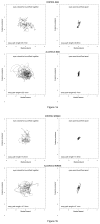Mechanisms of postural control in alcoholic men and women: biomechanical analysis of musculoskeletal coordination during quiet standing
- PMID: 20028360
- PMCID: PMC2858249
- DOI: 10.1111/j.1530-0277.2009.01118.x
Mechanisms of postural control in alcoholic men and women: biomechanical analysis of musculoskeletal coordination during quiet standing
Abstract
Background: Excessive sway during quiet standing is a common sequela of chronic alcoholism even with prolonged sobriety. Whether alcoholic men and women who have remained abstinent from alcohol for weeks to months differ from each other in the degree of residual postural instability and biomechanical control mechanisms has not been directly tested.
Method: We used a force platform to characterize center-of-pressure biomechanical features of postural sway, with and without stabilizing conditions from touch, vision, and stance, in 34 alcoholic men, 15 alcoholic women, 22 control men, and 29 control women. Groups were matched in age (49.4 years), general intelligence, socioeconomic status, and handedness. Each alcoholic group was sober for an average of 75 days.
Results: Analysis of postural sway when using all 3 stabilizing conditions versus none revealed diagnosis and sex differences in ability to balance. Alcoholics had significantly longer sway paths, especially in the anterior-posterior direction, than controls when maintaining erect posture without balance aids. With stabilizing conditions the sway paths of all groups shortened significantly, especially those of alcoholic men, who demonstrated a 3.1-fold improvement in sway path difference between the easiest and most challenging conditions; the remaining 3 groups, each showed a approximately 2.4-fold improvement. Application of a mechanical model to partition sway paths into open-loop and closed-loop postural control systems revealed that the sway paths of the alcoholic men but not alcoholic women were characterized by greater short-term (open-loop) diffusion coefficients without aids, often associated with muscle stiffening response. With stabilizing factors, all 4 groups showed similar long-term (closed loop) postural control. Correlations between cognitive abilities and closed-loop sway indices were more robust in alcoholic men than alcoholic women.
Conclusions: Reduction in sway and closed-loop activity during quiet standing with stabilizing factors shows some differential expression in men and women with histories of alcohol dependence. Nonetheless, enduring deficits in postural instability of both alcoholic men and alcoholic women suggest persisting liability for falling.
Figures






Similar articles
-
Disturbed sensory physiology underlies poor balance and disrupts activities of daily living in alcohol use disorder.Addict Biol. 2021 Jul;26(4):e12966. doi: 10.1111/adb.12966. Epub 2020 Oct 24. Addict Biol. 2021. PMID: 33098738 Free PMC article.
-
Physiological and focal cerebellar substrates of abnormal postural sway and tremor in alcoholic women.Biol Psychiatry. 2010 Jan 1;67(1):44-51. doi: 10.1016/j.biopsych.2009.08.008. Biol Psychiatry. 2010. PMID: 19782966 Free PMC article.
-
Postural sway reduction in aging men and women: relation to brain structure, cognitive status, and stabilizing factors.Neurobiol Aging. 2009 May;30(5):793-807. doi: 10.1016/j.neurobiolaging.2007.08.021. Epub 2007 Oct 24. Neurobiol Aging. 2009. PMID: 17920729 Free PMC article.
-
Effect of vision, touch and stance on cerebellar vermian-related sway and tremor: a quantitative physiological and MRI study.Cereb Cortex. 2006 Aug;16(8):1077-86. doi: 10.1093/cercor/bhj048. Epub 2005 Oct 12. Cereb Cortex. 2006. PMID: 16221930 Clinical Trial.
-
Altered postural control strategies in quiet standing more than 20 years after rupture of the anterior cruciate ligament.Gait Posture. 2016 May;46:98-103. doi: 10.1016/j.gaitpost.2016.02.020. Epub 2016 Mar 3. Gait Posture. 2016. PMID: 27131185
Cited by
-
Postural stability in cigarette smokers and during abstinence from alcohol.Alcohol Clin Exp Res. 2014 Jun;38(6):1753-60. doi: 10.1111/acer.12409. Epub 2014 Apr 9. Alcohol Clin Exp Res. 2014. PMID: 24721012 Free PMC article.
-
Contributions to Understanding the Neuropsychology of Alcoholism: An INS Legacy.J Int Neuropsychol Soc. 2017 Oct;23(9-10):843-859. doi: 10.1017/S1355617717000674. J Int Neuropsychol Soc. 2017. PMID: 29198270 Free PMC article. Review.
-
Disturbed sensory physiology underlies poor balance and disrupts activities of daily living in alcohol use disorder.Addict Biol. 2021 Jul;26(4):e12966. doi: 10.1111/adb.12966. Epub 2020 Oct 24. Addict Biol. 2021. PMID: 33098738 Free PMC article.
-
Gender differences in the effect of a 0.11% breath alcohol concentration on forward and backward gait.Sci Rep. 2022 Nov 5;12(1):18773. doi: 10.1038/s41598-022-23621-y. Sci Rep. 2022. PMID: 36335154 Free PMC article.
-
Reduced fronto-cerebellar functional connectivity in chronic alcoholic patients.Alcohol Clin Exp Res. 2012 Feb;36(2):294-301. doi: 10.1111/j.1530-0277.2011.01614.x. Epub 2011 Nov 15. Alcohol Clin Exp Res. 2012. PMID: 22085135 Free PMC article.
References
-
- American Psychiatric Association. Diagnostic and Statistical Manual of Mental Disorder (DSM-IV) American Psychiatric Association; Washington: 1994.
-
- Baloh RW, Ying SH, Jacobson KM. A longitudinal study of gait and balance dysfunction in normal older people. Arch Neurol. 2003;60(6):835–839. - PubMed
-
- Beatty WW, Hames KA, Blanco CR, Nixon SJ, Tivis LJ. Visuospatial perception, construction and memory in alcoholism. J Stud Alcohol. 1996;57:136–143. - PubMed
-
- Collins JJ, De Luca CJ. Open-loop and closed-loop control of posture: A random-walk analysis of center-of-pressure trajectories. Exp Brain Res. 1993;95:308–318. - PubMed
-
- Collins JJ, De Luca CJ. Upright, correlated random walks: A statistical-biomechanics approach to the human postural control system. Chaos. 1995;5(1):57–63. - PubMed
Publication types
MeSH terms
Grants and funding
LinkOut - more resources
Full Text Sources
Medical

